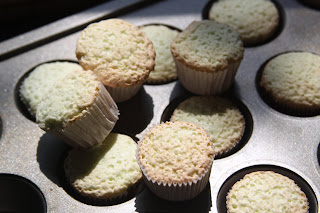Eureka! I have invented a recipe!
On the other hand, there might already be one out there, but I have to admit I didn't
intend to create a Buko-Pandan flavored Angel Food Cake. I had to do something with the
eggs whites that were left over from making the traditional Polish cream cake, Kremewka Papieska ( Kreh-MOOV-kah Pah-Pyess-Kah). It turned out delicious and uniquely pinoy in
lasa that it has earned a spot --at least in my blog-- as a Philippine style merienda. Most local groceries carry angel food cake in their bakery department, but I was surprised at how easy it was to make this dessert from scratch, considering that I've never made it before! This cake has a pastel green color from the pandan which I think made it rather pretty to look at. It has that light airy texture the cake is known for with the gratifying flavor of coconut and pandan.
I am serving this at the tureen supper along with the Kremewka Papieska and Sauerkraut Periogi at Fr. David Poulson's Induction Ceremony at St. Anthony's in Cambridge Springs, PA, tomorrow (May 14, 2011). Majority of the parishioners are Polish and I can't wait to see if they will also like the Buko-Pandan Angel Cake.
Buko-Pandan Angel Food Cake
Ingredients:
6 Large room temperature egg whites
1/2 teaspoon cream of tartar
1/8 teaspoon salt
1/4 cup tablespoons sugar
1/2 cup cake flour
1/2 teaspoon Buko-Pandan flavoring (McCormick brand is what I used)
1/2 cup sweetened flaked coconut
Whipped cream and sweetened flaked coconut for topping
Gawin mo 'to:
Heat oven to 325 degrees.
Whip egg whites until foamy. Add cream of tartar and salt. Whip until soft peaks form.
Add sugar in tablespoonful increments until stiff peaks form.
Add sugar in tablespoonful increments until stiff peaks form.
Sprinkle flour over egg whites in thirds, and carefully fold after each addition.
Add Buko-Pandan and continue folding until flavor is well mixed in.
Line mini muffin pan with baking cups and transfer a teaspoonful of the batter into the ungreased baking cup and bake for approximately 20 minutes. You'll know when it's done when the top layer develops a nice golden brown color or if toothpick comes out clean when poked in center of cake. It bakes pretty fast in a mini muffin pan so be careful you don't burn the cake. When cake has cooled down, top with whip cream, and a pinch of sweetened flaked coconut.
Isang hirit pa: Lightly sweet and airy, Angel Food Cake, was said to have originated in North America. What gives this a Philippine flare is the Buko (coconut) and Pandan (a tropical plant) flavoring. Angel Food Cake is supposedly the counterpart of Devil's Food Cake which incorporates butter (venial sin) and chocolate (mortal sin) in its recipe. Venial/mortal *giggle*
Learn a few Tagalog words....
Lasa (Lah-sah) means "Taste"
Gawin mo 'to (GAH-win Moh 'toh) means "Do this"
Gawin mo 'to (GAH-win Moh 'toh) means "Do this"
Isang hirit pa (E-Sang Hee-reet Pah) is street slang for "Here's another one"....or something like that.


